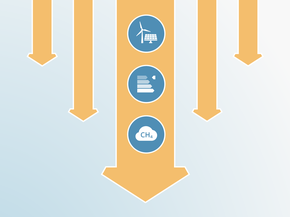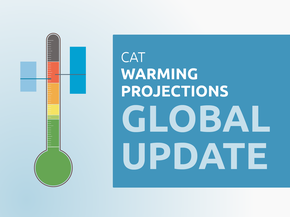Assumptions
Historical emissions
Historical emissions data is from Canada’s latest national inventory and covers the period to 2023 (Environment and Climate Change Canada, 2025)
NDC and other targets
2030 NDC target
We calculate a 40-45% reduction from base year emissions (2005), excluding LULUCF, and then subtract the projected LULUCF contribution in 2030. The LULUCF contribution ranges from our own estimates based on the trend over the last decade of Canada’s ‘LULUCF Accounting Contribution’ (an average of -8 MtCO2e sink) at one end, to the values in the government’s 2024 emissions projections (up to -28 MtCO2e sink in the additional measures scenario) at the other end. Canada’s estimated sink contributions are lower than the government’s previous estimate of -32 MtCO2e in its 2023 emissions projections (Environment and Climate Change Canada, 2023).
The reason that we include our own estimates to the LULUCF contribution is that, according to Canada’s 2024 emissions projections, the LULUCF Accounting Contribution, which is used by the government for target setting and evaluation, has historically been both a source and a sink. To account for the uncertainty in the government’s LULUCF projections, we added our own simplified estimates and show a range within which the expected values may fall.
Canada is still considering the extent to which it will rely on international carbon market credits (‘internationally transferred mitigation outcomes’ or ITMOs), however, it did indicate that it may use credits obtained under the Western Climate Initiative (a regional carbon market linking Quebec and California) for compliance with its 2030 target in its 8th National Communication (Government of Canada, 2022a). In its latest emissions projection report, that estimate for 2030 is 0.5MtCO2e (Government of Canada, 2024a).
We have added these potential credits to the NDC values we rate against modelled domestic pathways (i.e. the reductions that Canada should achieve within its borders), but subtract them in the NDC value we rate against the country’s fair share allocation.
2035 NDC target
Canada has committed to reducing emissions by 45–50% below 2005 levels by 2035. Canada calculates its target using a “gross-net” approach, meaning that the 2005 emissions level excludes the LULUCF sector, while its targeted emissions level in 2035 includes a specific subset of emissions from the LULUCF sector called the “Accounting Contribution.”
The CAT excludes LULUCF emissions for its NDC target assessment. To remove the LULUCF emissions in 2035, we estimate the level of the Accounting Contribution Canada plans to use in 2035 based on government projections and trends in historical data over the last 15 years.
Removing the estimated Accounting Contribution from Canada’s 2035 target results in an estimated emissions level of between 388–455 MtCO2e in 2035.
Current policy projections
Our current policy projection is based on the ‘Reference Case’, which is updated annually by the Government of Canada, harmonised to the last historical year of 2023 (Government of Canada, 2024a).
The government’s projections include policy measures in place as of August 2024. Notably, in April 2025, the federal government eliminated the consumer carbon price from Canada’s carbon pricing system. According to analysis from the Canadian Climate Institute, the consumer carbon price was estimated to reduce between 17–19 MtCO2e in 2030 in the legislated policy scenario. We have adjusted our current policy projection to reflect this change by removing 17–19 MtCO2e. The expected emissions reductions from the policy in a given year were scaled relative to the carbon price (CAD 80/tonne in 2024 rising to CAD 170/tonne in 2030). For instance, in 2025, we project emissions reductions from the consumer carbon price to be between 10–11 MtCO2e.
Beyond that change, we consider the current policy projection to be an up-to-date, albeit optimistic, picture of the policy landscape as of August 2025. We consider the projection to be optimistic as it assumes full and effective implementation of all current policies. For example, the projection presumes that industrial carbon pricing will be implemented strictly according to federal rules, such as a binding CAD 170/tonne carbon price in 2030. In reality, the effectiveness of this system is likely to be undermined by several factors, including the interaction between carbon pricing and other policies, design issues, and ongoing provincial resistance to federal requirements. The weaknesses of the current system are expected to lead to fewer emissions than the government projects (Linden-Fraser et al., 2025). While the exact impact of these factors is difficult to quantify, together they represent a significant risk that actual outcomes will fall short of projections.
We do not include any contribution from LULUCF or carbon credits from the Western Climate Initiative in our estimates.
Planned policy projections
Our planned policy projection is based on the ‘with additional measures’ scenario provided by the government in its annual projections data, harmonised to the last historical emissions year of 2023 (Government of Canada, 2024a). As with the current policy projections, we have adjusted the government’s projections to remove the impact of the consumer carbon price. According to analysis by the Canadian Climate Institute, the consumer carbon price was expected to reduce emissions by between 15–19 MtCO2e in 2030 in the announced policy scenario. We have adjusted our planned policy projection to reflect this change by removing 15–19 MtCO2e.
Net zero target and other long-term targets
Canada’s net zero strategy assumes a 100 MtCO2e sink in 2050 to assist with achieving the country’s net zero target. We use this value for the residual emissions to calculate their net zero target excluding LULUCF (Environment and Climate Change Canada, 2022c).
Global warming potentials values
The CAT uses Global Warming Potential (GWP) values from the IPCC’s Fifth Assessment Report (AR5) for all its figures and time series unless stated otherwise. Assessments completed prior to June 2025 used GWP values from the Fourth Assessment Report (AR4), and those completed prior to December 2018 (COP24) used GWP values from the Second Assessment Report (SAR).
Further analysis
Latest publications
Stay informed
Subscribe to our newsletter




